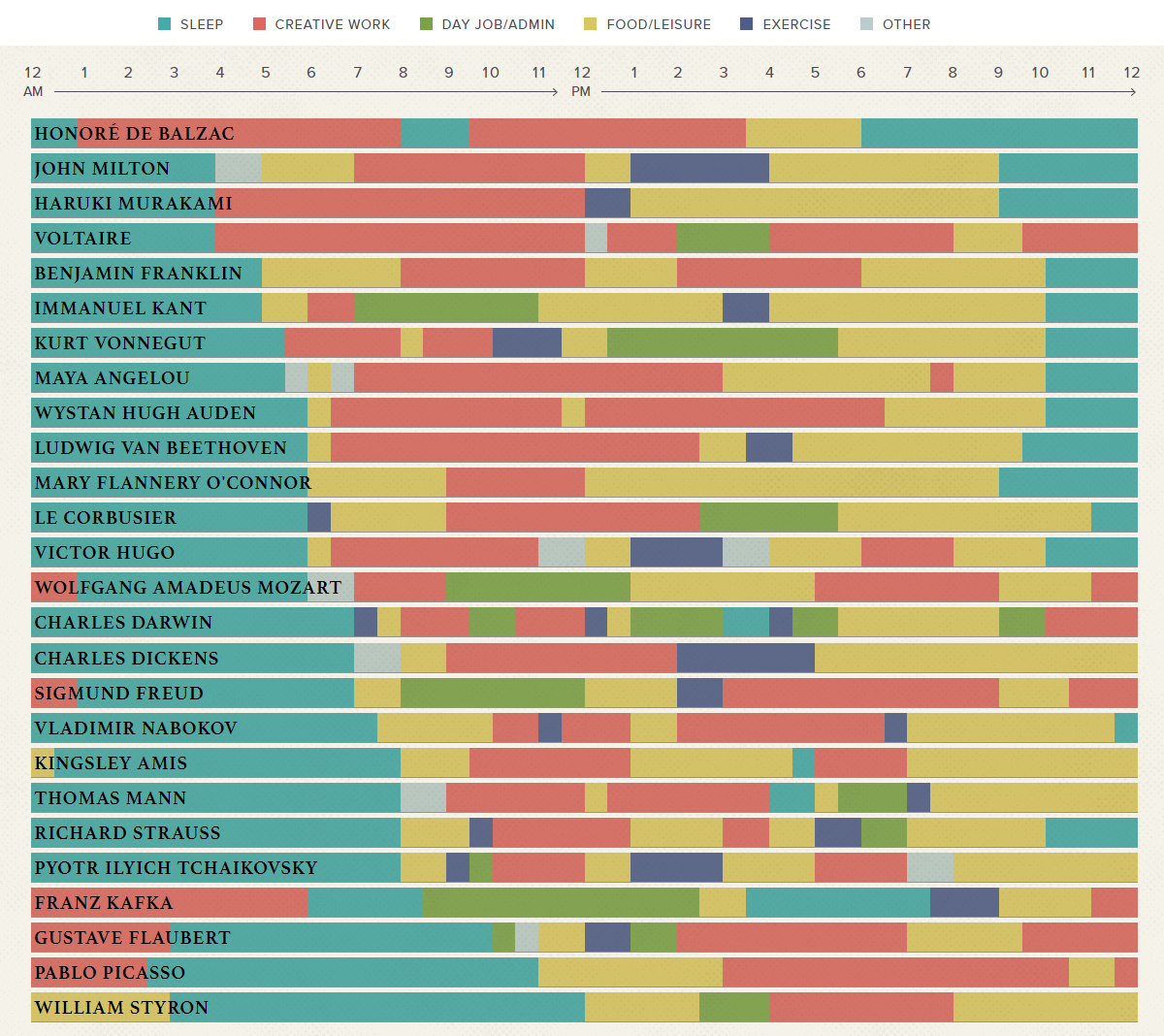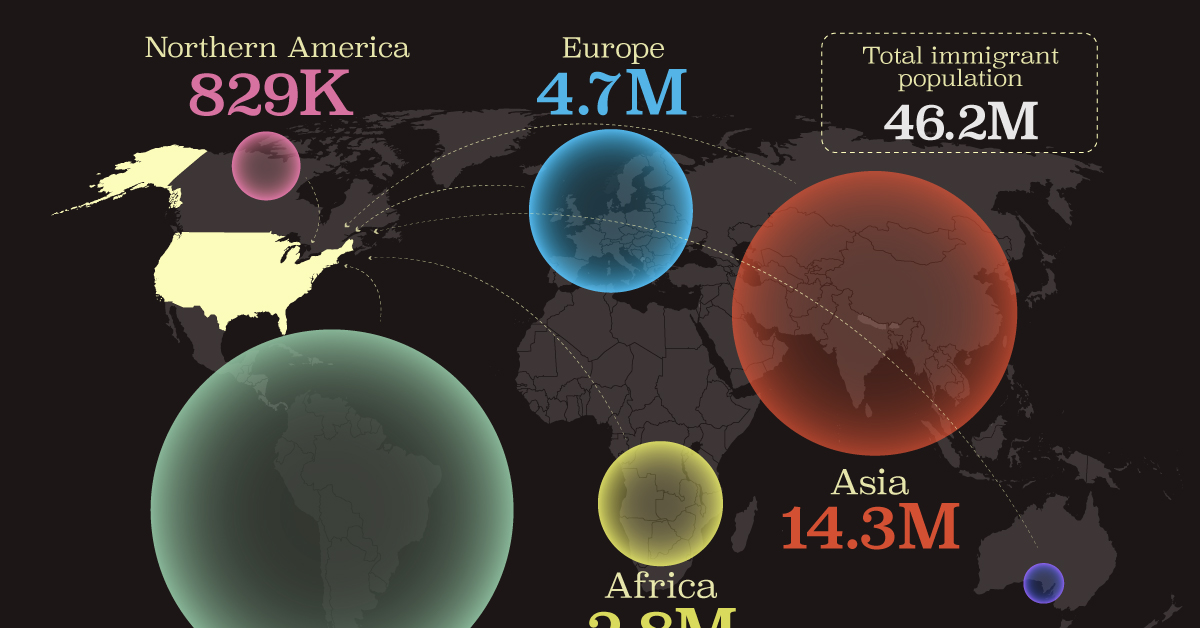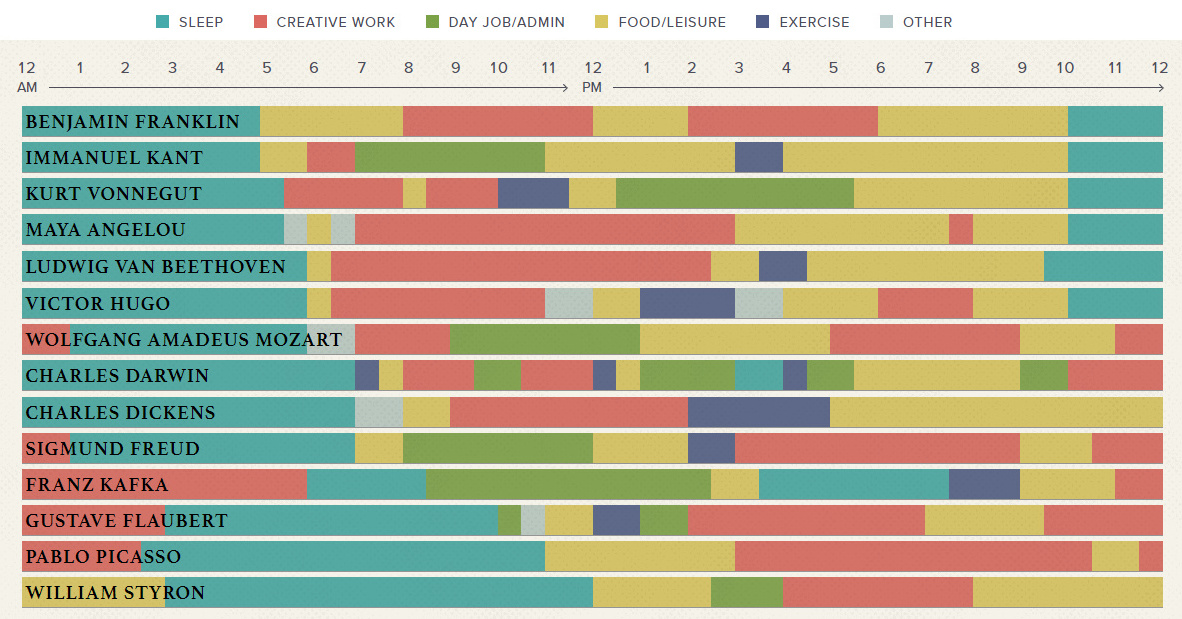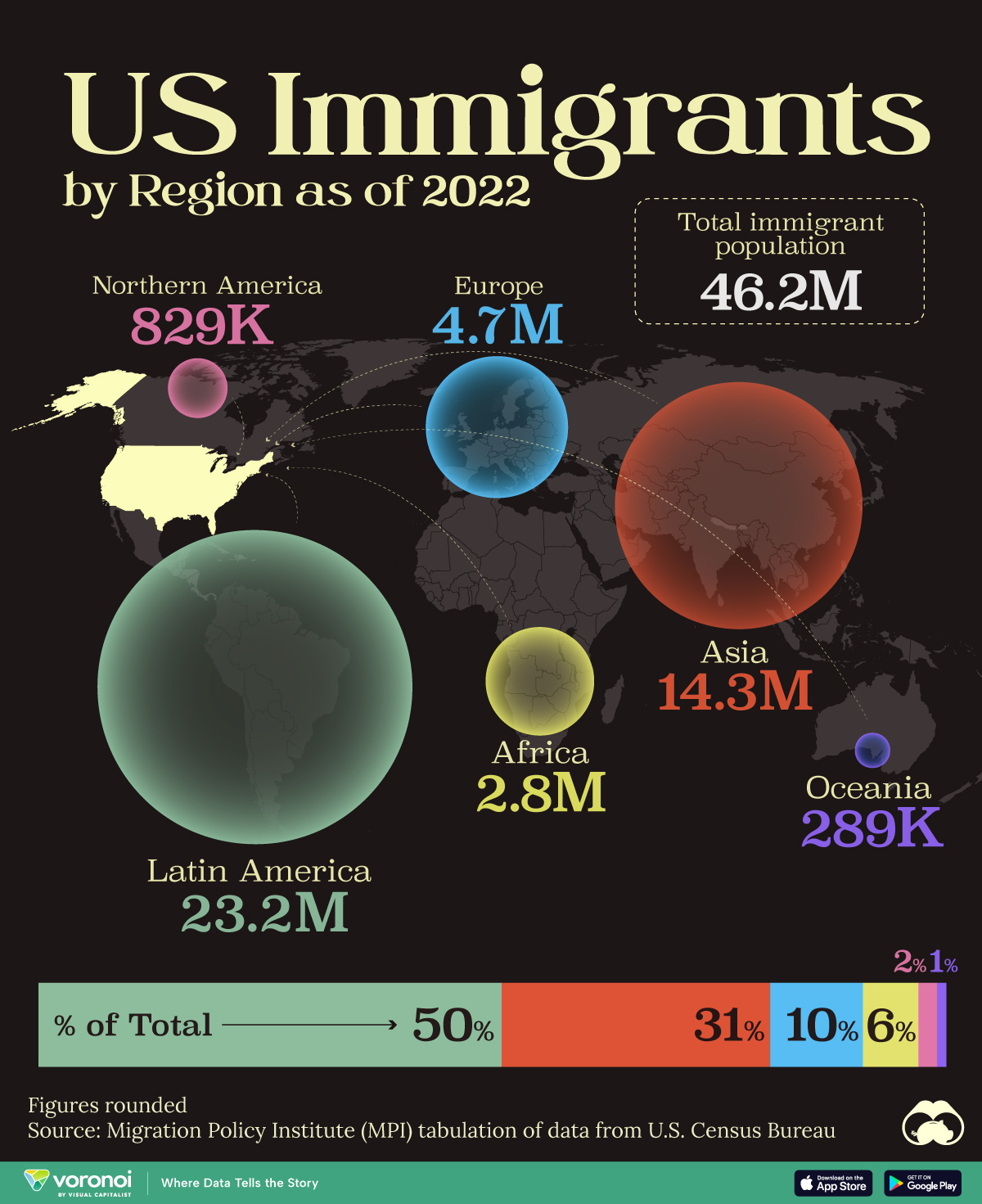Misc
Visualizing the Daily Routines of Famous Creative People

Visualizing the Daily Routines of Famous Creative People
Creative people have a reputation for circumventing convention.
After all, if creatives always did things the same way as everyone else, how could they ever produce anything original and truly unique?
While it’s not always easy to do things differently, the most famous creative people throughout history have almost always followed their own paths. The end result, thankfully for us, is a wealth of original art that has served to inspire generation upon generation.
Time Well Spent
Today’s chart comes to us from Podio and it breaks down the daily routines of famous creative people, such as Pablo Picasso, Mozart, Maya Angelou, or Benjamin Franklin.
We highly recommend the interactive version which allows you to highlight segments of the chart to see more specific details on the routines of each creative person.
It’s also worth noting that the routines listed don’t necessarily represent the exact everyday activities for the listed creatives – instead, they are representations of what’s been recorded in diaries, journals, letters, or other literature by these greats themselves.
Finally, most of the data comes from the book Daily Rituals: How Artists Work by Mason Currey.
Unconventional Habits of Creative Geniuses
Here are some of the creatives that had some of the most unusual and eccentric routines:
Ludwig van Beethoven
The famous German composer and pianist was a coffee addict, and would count exactly 60 beans for each cup of joe he consumed.
Franz Kafka
The novelist would have strong bouts of insomnia and often hallucinated. This condition shaped his creative process, and he stated in his journal that he only knew the type of writing in which “fear [kept him] from sleeping”.
Honoré de Balzac
The French novelist and playwright “[went] to bed at six or seven in the evening, like the chickens” and started working just after midnight. When he worked, he wore “Moroccan slippers” and a “notorious white monkish robe with a belt of Venetian gold”. In his defense, with this type of routine, he was able to write 85 novels in 20 years.
W.H. Auden
The English-American poet took Benzedrine – an amphetamine – every morning for 20 years as a systematic part of his routine and creative process. He balanced its use with the barbiturate Seconal, for when he wanted to sleep. He called amphetamines a “labor-saving device” that gave direct energy to his work.
Victor Hugo
The French poet, novelist, and dramatist, best known for penning Les Misérables and The Hunchback of Notre-Dame, had very busy and eclectic days.
His breakfast would include coffee and two raw eggs, and after working for a few hours in the morning, he would take an ice bath on the roof. In the afternoon, he would try to fit in a quick visit with his barber, a date with his mistress, and also some strenuous exercise. In the evening, he would write some more, and then play cards and go out with friends.
The Reputation Lives On
Rightfully or wrongfully deserved, the reputation of creative geniuses for doing things differently is something that will likely continue to live on – and the rest of the world will likely pass judgement so long as they continue to receive the fruits of their labors.
Demographics
Mapped: U.S. Immigrants by Region
This map shows which regions U.S. immigrants came from, highlighting Asia and Latin America as the biggest sources.

Breaking Down America’s Immigrant Population
This was originally posted on our Voronoi app. Download the app for free on iOS or Android and discover incredible data-driven charts from a variety of trusted sources.
The United States is home to more immigrants than any other nation, surpassing the combined totals of the next four countries: Germany, Saudi Arabia, Russia, and the United Kingdom.
To add context to this impressive fact, we’ve illustrated the regions from which U.S. immigrants originated. “Immigrants” in this context refers to individuals who are residing in the United States but were not U.S. citizens at birth.
These statistics were sourced from the Migration Policy Institute, which analyzed data from the U.S. Census Bureau’s 2022 American Community Survey (ACS).
U.S. Immigrants by Region
From this graphic, we can see that Asia and Latin America emerge as the primary sources of immigration, collectively accounting for 81% of America’s 46.2 million immigrants.
| Region | # of Immigrants | % of Total |
|---|---|---|
| Europe | 4,728,948 | 10 |
| Asia | 14,349,080 | 31 |
| Africa | 2,752,965 | 6 |
| Oceania | 288,560 | 1 |
| Northern America | 828,702 | 2 |
| Latin America | 23,233,834 | 50 |
| Total | 46,182,089 | 100 |
Latin America alone contributes half of the immigrant population. Mexico stands out as the largest contributor to U.S. immigration, with 10.7 million immigrants, attributable to its geographical proximity and historical ties.
Economic factors, including wage disparity and employment opportunities, drive many Mexicans to seek better prospects north of the border.
From Asia, the two largest country sources are China (2.2 million) and India (2.8 million).
Learn More About U.S. Immigration From Visual Capitalist
If you enjoyed this post, be sure to check out Why Do People Immigrate to the U.S.? This visualization shows the different reasons why immigrants chose to come to America in 2021.
-

 Brands5 days ago
Brands5 days agoThe Evolution of U.S. Beer Logos
-

 Culture2 weeks ago
Culture2 weeks agoThe World’s Top Media Franchises by All-Time Revenue
-

 voronoi2 weeks ago
voronoi2 weeks agoBest Visualizations of April on the Voronoi App
-

 Wealth2 weeks ago
Wealth2 weeks agoCharted: Which Country Has the Most Billionaires in 2024?
-

 Business1 week ago
Business1 week agoThe Top Private Equity Firms by Country
-

 Markets1 week ago
Markets1 week agoThe Best U.S. Companies to Work for According to LinkedIn
-

 Economy1 week ago
Economy1 week agoRanked: The Top 20 Countries in Debt to China
-

 Politics1 week ago
Politics1 week agoCharted: Trust in Government Institutions by G7 Countries




